Leather, with its durability and timeless appeal, is a popular choice for various items such as furniture, handbags, and jackets. However, a common issue faced by many is the rubbing off of the dye, which can lead to unsightly stains and discoloration. Knowing how to prevent leather dye from rubbing off can not only extend the lifespan of your leather goods but also preserve their visual charm. In this guide, we will explore a few proactive steps to address this issue.
Understanding Leather Dye
Leather is a popular material used for a variety of products, including clothing, accessories, furniture and car interiors. It is durable, stylish and can be dyed in a range of colors to suit individual preferences.
Leather dye is a type of coloring agent that is specifically designed for use on leather. It comes in various forms such as liquids, creams or sprays and is applied to the surface of leather to imbue it with color. However, one common problem that many people face when using leather dye is that it often rubs off onto other surfaces such as clothing, skin or furniture.
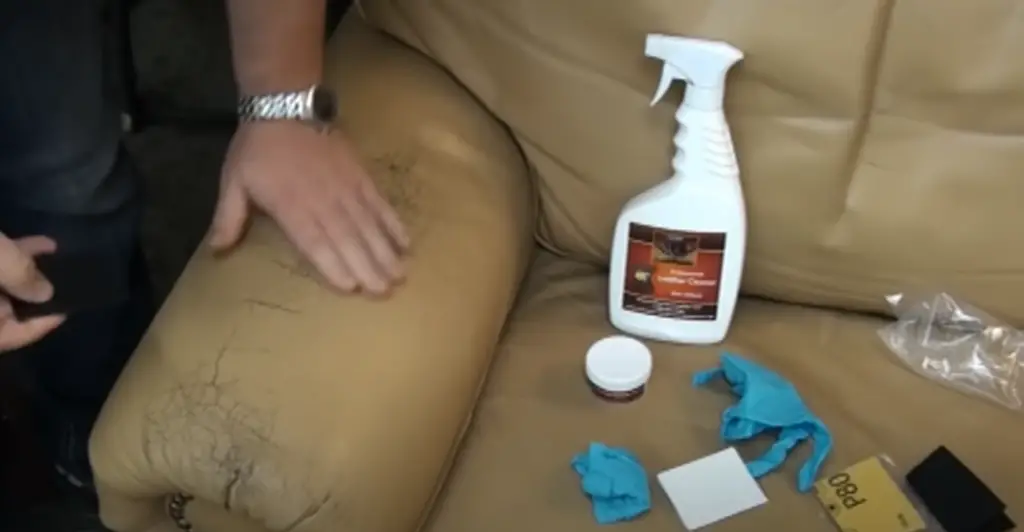
Factors Contributing to Dye Rubbing Off
There are several factors that can contribute to leather dye rubbing off. One of the main reasons is the quality of the dye itself. Low-quality dyes may not adhere well to the leather surface and can easily rub off when in contact with other surfaces.
Additionally, the preparation and application of the dye can also play a role in its tendency to rub off. If the leather is not properly cleaned and prepared before dyeing, the dye may not adhere well. Similarly, if the dye is applied too thickly or unevenly, it may be more likely to rub off. [1]
Prevention and Solutions
To prevent leather dye from rubbing off, it is important to start with high-quality dyes specifically made for use on leather. Before applying the dye to the entire surface, it is always advisable to test a small, inconspicuous area of the leather first. This precaution ensures that any undesired effects can be identified and avoided before proceeding further.
Properly preparing the leather before applying the dye is also crucial. Any oils, waxes or resins should be removed from the surface using a degreasing agent. The leather should then be cleaned and dried thoroughly before applying the dye.
During application, it is important to follow instructions carefully and apply the dye evenly in thin layers. Multiple coats may be necessary to achieve the desired color, but it is important to let each layer dry completely before applying the next one.
In case leather dye still rubs off despite proper preparation and application, there are some temporary solutions that can be used. These include using a colorless sealer or setting the dye with heat, such as using a hairdryer. However, these solutions may not be permanent and the dye may still rub off over time.
Proper Cleaning and Conditioning
Another important factor in preventing leather dye from rubbing off is proper cleaning and conditioning of the leather. Consistently cleaning and conditioning leather is crucial to maintain its pristine condition and prevent any potential damage that could lead to color fading.
It is recommended to use products specifically made for leather, such as a gentle cleaner and conditioner. These will not only clean the surface but also provide nourishment and protection for the leather, making it less susceptible to dye rubbing off. [2]
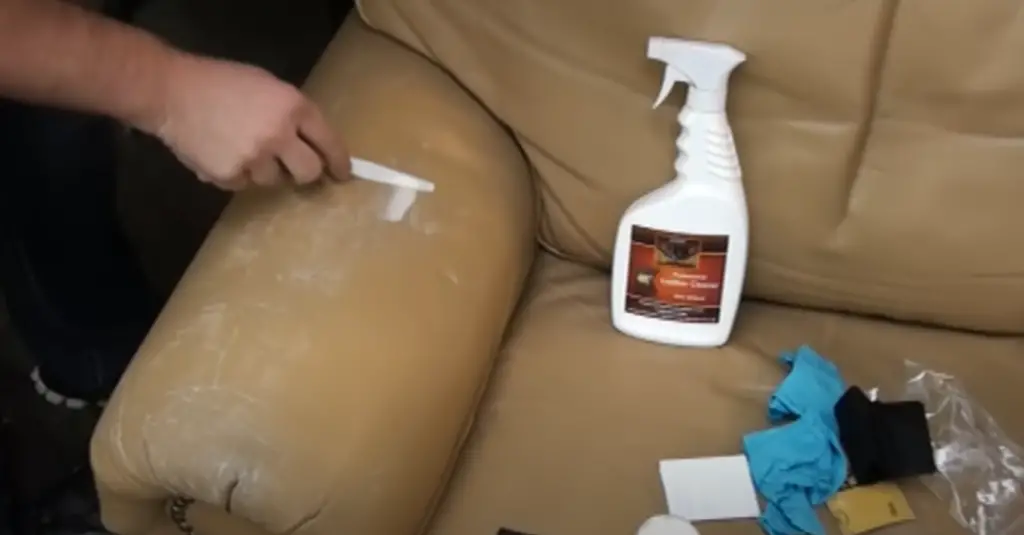
Applying a Protective Coat to Prevent Leather Dye from Rubbing Off
When dealing with leather products, a major concern arises regarding the prevention of dye transfer onto clothing or other surfaces. This can be especially frustrating if you have invested in quality leather goods and want them to last a long time.
Luckily, there are some steps you can take to protect your leather and prevent the dye from rubbing off. One of the most effective methods is to apply a protective coat to the leather.
Why Apply a Protective Coat?
Leather dyes, particularly those used on unfinished or unsealed leather, can easily rub off onto other surfaces. This is because the dye sits on top of the leather instead of penetrating and bonding with it. Additionally, oils from your skin and other external factors can further accelerate the rubbing off of dye.
By applying a protective coat, you create a barrier between the leather and any potential sources of friction. This not only helps prevent dye from rubbing off onto clothing, but it also adds an extra layer of protection against stains and water damage.
Choosing the Right Protective Coat
When selecting a protective coat for your leather, it’s important to choose one that is specifically designed for use on leather products. Avoid using household cleaners or polishes, as these may contain harsh chemicals that can damage the leather.
Instead, look for protective coats made with natural ingredients such as beeswax or lanolin, which are gentle and nourishing for the leather. Some protective coats also come in spray form, making them easier to apply evenly over larger surfaces.
Applying the Protective Coat
Before applying the protective coat, make sure your leather is clean and dry. Gently wipe down the surface with a damp cloth to remove any dirt or dust that may be present. Allow the leather to fully dry before proceeding.
After applying the protective coat, allow it to dry completely before using your leather product. It’s recommended to let the product sit overnight for optimal results. [3]

Maintaining the Protective Coat
Over time, the protective coat may wear off due to regular use and exposure to external factors. To maintain its effectiveness, reapply the protective coat every few months or as needed.
In addition, it’s important to avoid using any harsh chemicals or cleaners on your leather products, as these can strip away the protective coat and leave your leather vulnerable to dye transfer.
Avoiding Contact with Harsh Chemicals
In addition to applying a protective coat, it’s important to avoid contact with harsh chemicals that can damage the leather and cause dye transfer. Some common household cleaners and products that should be avoided include:
- Bleach
- Ammonia
- Alcohol-based products
- Acetone or nail polish remover
Instead, opt for gentle cleaning solutions specifically designed for use on leather, or make your own using natural ingredients like vinegar and olive oil. [4]
How to Fix Rubbing Off Leather Dye?
If you have already noticed dye transfer on your clothing or other surfaces, don’t worry – there are ways to fix the issue.
First and foremost, act quickly. The longer the dye sits on the surface, the harder it will be to remove. Using a clean cloth or sponge, gently dab at the affected area with cold water and mild soap. Avoid rubbing or scrubbing, as this can spread the dye and make it more difficult to remove.
If there is still some residual dye left on the surface, you can try using a leather cleaner specifically designed for removing stains. Follow the instructions carefully and test it on a small inconspicuous area first before applying it to the entire affected area.
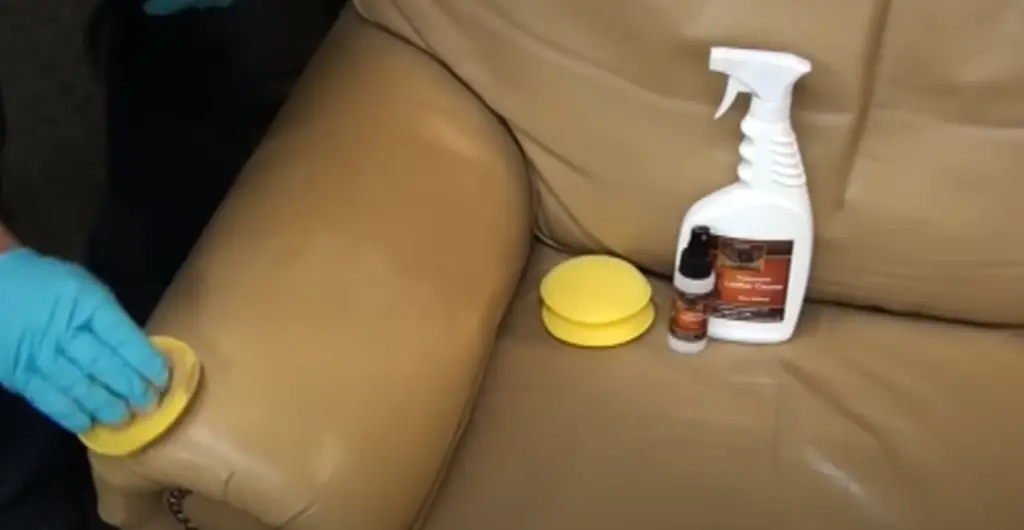
Treating Leather with Sealant
For those who regularly experience issues with dye transfer from their leather products, it may be worth considering treating the leather with a sealant. This is especially beneficial for unfinished or unsealed leathers that are more prone to dye transfer.
A sealant works by sealing the pores of the leather, preventing dye from rubbing off onto other surfaces. It also helps protect the leather from damage and prolongs its lifespan. However, keep in mind that using a sealant may alter the appearance and texture of the leather, so it’s important to test it on a small area first before applying it to the entire surface.
Types of Sealants
There are various types of sealants available on the market that can help prevent leather dye from rubbing off. Each type has its own unique properties and uses, so it’s important to choose the right one for your specific needs.
Wax Sealants
Wax sealants create a protective barrier on the surface of the leather, helping to prevent dye transfer and color fading. They are commonly used on leather shoes, jackets, and bags. Wax sealants can also add a glossy finish to the leather, giving it a polished look. [5]
Resin Sealants
Resin sealants work by bonding with the leather fibers, creating a strong barrier against dye transfer and color fading. They are often used on high-end leather goods such as furniture and car interiors. Resin sealants can also provide a matte finish to the leather, giving it a more natural look.
Acrylic Sealants
Acrylic sealants are water-based and offer good protection against dye transfer and color fading. They are commonly used on leather furniture, as they do not alter the appearance of the leather. Acrylic sealants dry clear and are easy to apply.
Silicone Sealants
Silicone sealants are another popular option for protecting leather from dye transfer and color fading. They create a waterproof barrier on the surface of the leather, making them ideal for use on outdoor gear such as boots and jackets. Silicone sealants can also add a slight sheen to the leather.
![]()
Choosing the Right Sealant
When choosing a sealant for your leather, consider the type of leather and its intended use. Some sealants may be better suited for certain types of leather or specific purposes. It’s also important to follow the manufacturer’s instructions carefully when applying a sealant to ensure maximum effectiveness.
Additional Tips
Aside from using a sealant, there are other steps you can take to prevent dye transfer and color fading on leather. Here are a few tips:
- Avoid wearing light-colored clothing when using or sitting on dyed leather.
- Protect your leather goods from direct sunlight, as UV rays can cause dye to fade.
- Use a soft cloth or brush to gently dust off any dirt or debris on the surface of the leather.
- If you notice any signs of dye transfer, immediately use a damp cloth to gently blot the affected area.
Benefits of Using Sealant for Leather Dye
Leather dye can add a pop of color and personality to any leather item, whether it’s a jacket, bag, or furniture piece. However, one common issue with using leather dye is that it can rub off onto clothing or other surfaces. This not only causes stains but can also ruin the overall look of the dyed item.
To prevent this from happening, many people opt to use a sealant for their leather dye. Here are some of the benefits of using a sealant for leather dye:
- Protection against rubbing and fading: The main purpose of using a sealant is to protect the dyed leather from rubbing off onto other surfaces or fading over time. Sealants create a barrier between the dye and external elements, keeping the color intact and preventing any transfer.
- Long-lasting results: By using a sealant, you can ensure that your leather dye will stay vibrant for a longer period of time. This is especially important for frequently used items like purses or jackets which are exposed to wear and tear on a daily basis.
- Moisture resistance: Leather is susceptible to moisture and water can cause the dye to run or fade. A sealant helps create a water-resistant layer over the dyed leather, providing added protection and preventing any damage from moisture.
- Adds shine: Some sealants also have a glossy finish which can enhance the overall look of your leather item. This can be particularly beneficial for items like shoes or accessories that you want to have a shiny appearance.
- Easy application: Most sealants come in spray or brush-on form, making them easy to apply. You can simply spray or paint the sealant onto the dyed leather and let it dry for a few hours before using the item. This makes it a convenient option for those who want to protect their leather dye without much hassle.
Overall, using a sealant for leather dye is a great way to ensure that your dyed items stay looking vibrant and new. With the added benefits of protection, longevity, moisture resistance, and shine, it’s a simple step that can go a long way in preserving the beauty of your leather pieces. So next time you dye your leather item, don’t forget to seal it for optimal results! [6]
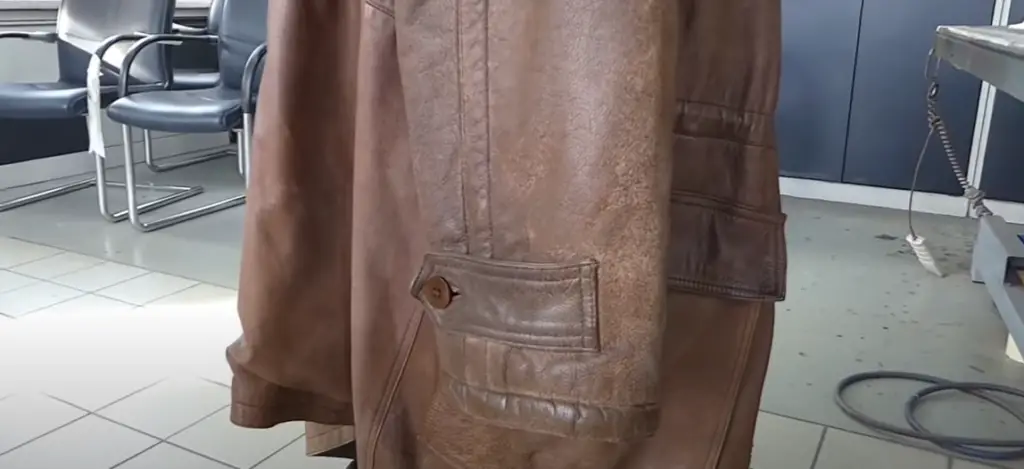
Additional Tips for Maintaining Colored Leather
Aside from using a sealant, there are other tips you can follow to maintain the color and quality of your colored leather items:
- Avoid direct sunlight: Exposure to sunlight can cause leather dye to fade or change color. If possible, store your dyed leather items in a cool and dark place.
- Use appropriate cleaners: When cleaning your dyed leather item, be sure to use a cleaner specifically formulated for leather. Harsh chemicals can strip the dye and damage the material.
- Test on a small area: Before applying any product or cleaner to your dyed leather, it’s best to test it on a small, inconspicuous area first. This will ensure that the product doesn’t cause any unwanted reactions or damage.
- Re-dye when necessary: Over time, leather dye may start to fade or wear off in certain areas. Instead of constantly trying to fix and touch up the color, it may be more beneficial to re-dye the entire item for a fresh and uniform look.
Re-Dyeing the Leather Professionally
One way to prevent leather dye from rubbing off is by getting it professionally re-dyed. This option may be more expensive, but it can guarantee a longer-lasting and better quality result.
There are two main methods used in professional re-dyeing: hot-stamping and airbrushing.
Hot-Stamping
Hot-stamping is the process of using heat and pressure to bond the dye onto the leather. This method is commonly used for larger areas of leather, such as car seats or furniture. The heated dye penetrates deeper into the leather fibers, making it more resistant to rubbing off.
Airbrushing
Airbrushing involves using an airgun to spray a fine mist of dye onto the surface of the leather. This method is often used for smaller, more intricate designs or details on leather goods. The dye adheres to the surface of the leather, creating a smooth and even finish.
Both methods require specialized equipment and expertise, which is why professional re-dyeing can be expensive. However, it can be a worthwhile investment if you want your leather goods to look as good as new and last for a long time. [7]
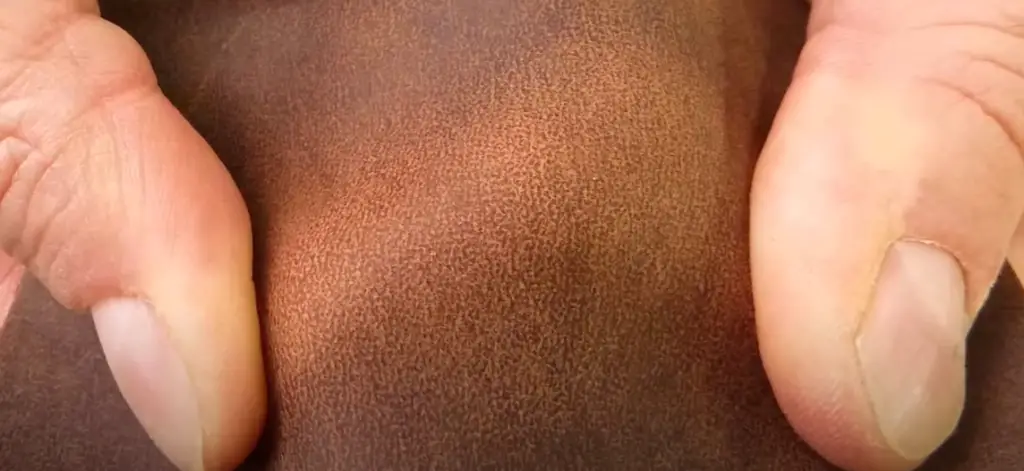
FAQs
What is the best way to prevent leather dye from rubbing off?
Aside from getting it professionally re-dyed, some DIY solutions include using a sealant or topcoat to protect the dye from rubbing off, as well as regularly conditioning and moisturizing the leather.
How often should I get my leather goods re-dyed?
This ultimately depends on how frequently you use them and in what conditions. For high-traffic items like shoes or bags, it may be necessary to get them re-dyed every year or so. For less frequently used items, every few years may suffice.
Can I re-dye leather myself?
While it is possible to re-dye leather at home, it can be a challenging and time-consuming process. It also requires specific tools and products, as well as knowledge and skill in applying the dye evenly. It may be best to leave it to the professionals for optimal results.
Are there any precautions I should take after getting my leather re-dyed?
It is essential to follow the care instructions provided by the professional who re-dyed your leather goods. This may include avoiding certain types of cleaners or exposing them to harsh elements that could damage the dye. Regularly conditioning and moisturizing the leather can also help maintain its color and prevent it from rubbing off.
What type of sealant should I use to prevent leather dye from rubbing off?
There are various sealants and topcoats available specifically for leather, such as acrylic or resin-based products. It is best to consult with a professional or do thorough research to determine which type would be most suitable for your specific leather goods. Overall, using a sealant can help protect the dye from rubbing off and extend the lifespan of your leather items.
Is there a specific type of leather dye that does not rub off easily?
There are leather dyes that are specifically formulated to be more resistant to rubbing off, such as oil-based or alcohol-based dyes. However, it is still essential to take proper precautions and regularly maintain the dye to prevent it from wearing off over time. Consulting with a professional can also help determine the best type of dye for your specific needs.
Does the quality of leather affect the tendency of the dye to rub off?
The quality and type of leather can have an impact on the durability of the dye. Top-grain or full-grain leather, which is made from the top layer of the hide, tends to be more resistant to rubbing off compared to split leather or suede. However, regardless of the type of leather, proper care and maintenance are essential in preserving the dye’s color and preventing it from rubbing off.
Is getting leather goods re-dyed worth the cost?
This ultimately depends on personal preference and the value one places on their leather items. Re-dyeing can be a costly process, but it can also significantly extend the lifespan of your leather goods and restore them to their original appearance. If you have high-quality or sentimental leather items, it may be worth the investment to keep them looking their best. As with any decision, it is important to weigh the pros and cons and determine what is best for you and your budget.
Can I re-dye my leather item if the dye has already started to rub off?
In some cases, it may be possible to re-dye a leather item that has already started to show signs of dye rubbing off. However, this can be more challenging and may not always provide the desired results. It is essential to consult with a professional before attempting to re-dye any leather goods in order to minimize potential damage or further issues. Regularly maintaining and caring for leather goods can also help prevent the need for re-dyeing in the future.
What should I do if I notice my leather dye rubbing off onto other items?
If you notice your leather dye rubbing off onto other items, it is important to address the issue as soon as possible. Using a sealant or topcoat on the affected item may help prevent further rubbing off. It is also crucial to properly clean and condition the leather, as well as avoiding exposure to harsh elements that may contribute to additional dye transfer. If the issue persists, consulting with a professional or getting the item re-dyed may be necessary.
Does Vaseline seal leather dye?
While Vaseline may temporarily provide a barrier against dye transfer, it is not a reliable or long-term solution for preventing leather dye from rubbing off. It is important to use products specifically designed for sealing and protecting the color of leather. Avoid using any untested methods on your leather goods, as they may cause damage or worsen the issue. If in doubt, consult with a professional or do thorough research before attempting to seal the dye on your leather items.
Do you oil leather before or after dye?
It is generally recommended to oil and condition leather after dyeing. This helps maintain the moisture in the leather, which can prevent it from drying out and cracking. However, every type of leather and dye may have different recommendations or requirements, so it is best to consult with a professional before attempting any DIY methods.
Useful Video: Leather Couch Cleaning and Restoration
Conclusion
In conclusion, leather dye can rub off over time due to wear and tear, exposure to harsh elements, or improper maintenance. However, there are professional solutions available to re-dye leather goods and prevent the dye from rubbing off in the future. By understanding different techniques such as hand dyeing or airbrushing, taking proper precautions with sealants and topcoats, and regularly maintaining leather items, you can keep them looking vibrant and new for years to come. It is also essential to consult with a professional or do thorough research before attempting any DIY re-dyeing methods. Ultimately, protecting the dye on your leather goods can help extend their lifespan and maintain their overall quality and appearance.
References:
- https://www.theleathercolourdoctor.co.uk/why-is-my-leather-dye-rubbing-off/
- https://diyquickly.com/how-to-stop-leather-dye-from-rubbing-off/
- https://organizing.tv/how-to-stop-leather-from-staining-clothes/
- https://www.bladesmithsforum.com/index.php?/topic/39201-leather-dye-rubbing-off/
- https://www.warrington-worldwide.co.uk/2022/08/11/leather-dyeing-diy-why-it-might-not-work/
- https://oureverydaylife.com/how-to-keep-dyed-leather-from-rubbing-off-on-clothes-12597567.html
- https://myleathertravelbag.com/stop-staining-clothes/

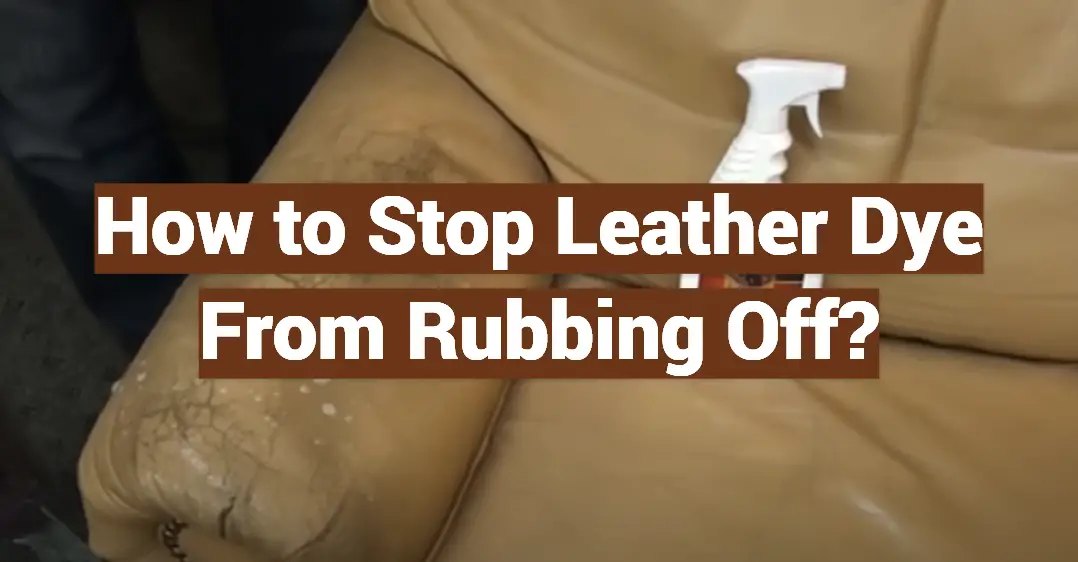
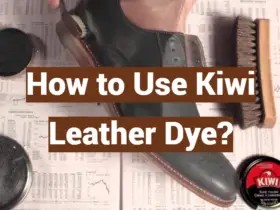
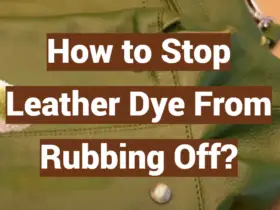

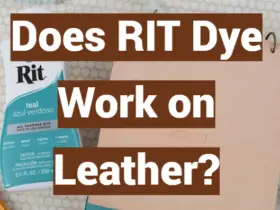

Leave a Reply